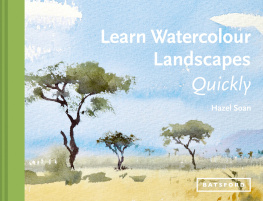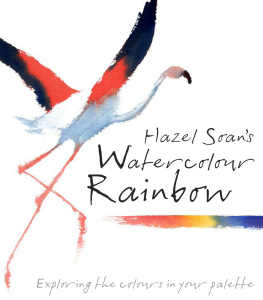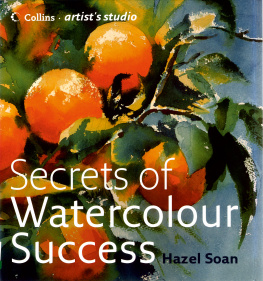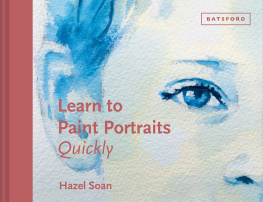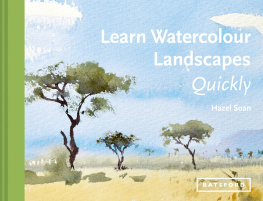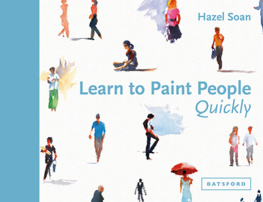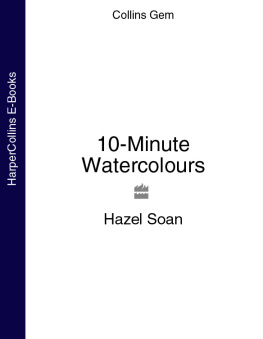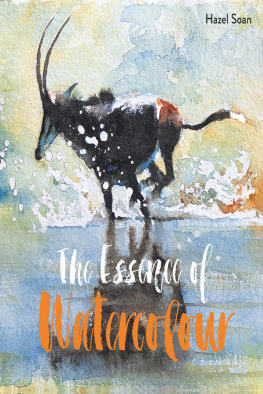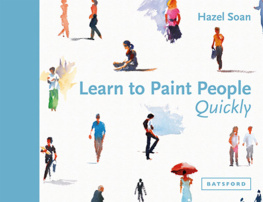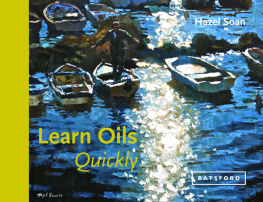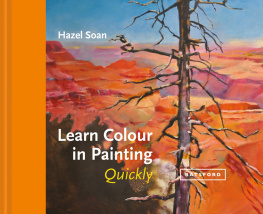Contents
Guide


Learn Watercolour Landscapes
Quickly
Hazel Soan

To the Initiator of the Big Bang, for Planet Earth
First published in the United Kingdom in 2020 by
Batsford
43 Great Ormond Street
London
WC1N 3HZ
An imprint of Pavilion Books Company Ltd
Copyright Pavilion Books Company Ltd 2020
Text and paintings Hazel Soan 2020
All rights reserved. No part of this publication may be copied, displayed, extracted, reproduced, utilised, stored in a retrieval system or transmitted in any form or by any means, electronic, mechanical or otherwise including but not limited to photocopying, recording or scanning without the prior written permission of the publisher.
ISBN 978-1-84994-677-3
A CIP catalogue record for this book is available from the British Library
This book can be ordered direct from the publisher at
www.pavilionbooks.com
Acknowledgements
I wish to thank Tina Persaud for asking me to write this book and my editor, Lilly Phelan, and the designer, Sarah Pyke, for bringing it so expertly into being. It has been a pleasure. Thank you to everyone at Pavilion for making book-writing so enjoyable. Thanks must go to my husband for his driving skills, which have enabled me to paint in remote landscapes in Africa and North America, a privilege I have always appreciated. I also wish to thank Cathy Gosling for being a constant inspiration and companion of the mind.

Contents
CHAPTER 1
Creating Space
CHAPTER 2
Focus on Composition
CHAPTER 3
Light and Colour
CHAPTER 4
Landscape Techniques
CHAPTER 5
Landscape Themes
CHAPTER 6
Epilogue
Introduction
Watercolour landscape painting is an exciting process. It takes a piece of the huge wide world, shrinks it to paper size, flattens it into two dimensions and creates something that did not exist before. Though it may resemble the landscape the artist sees, it is not the landscape, nor is it a copy it is a new creation, a watercolour painting. I find this creative metamorphosis rather magical. How is it possible? Read on and find out.

Little is needed to suggest a landscape.

West Virginia Byway
28 x 38cm (11 x 15in)
The characteristics of the watercolour medium are so attractive in themselves that a mundane subject, such as these two roadside sheds, makes an enjoyable painting with just three colours Alizarin Crimson, Aureolin and Ultramarine Blue and a play of light and shade.
The art of illusion
The magic that makes landscape painting possible is the art of illusion. With the use of tone, colour and perspective, the artist has the means to convince the viewer that a three-dimensional world is reinvented on the flat surface of the paper. Watercolour is the perfect accomplice in this illusion; lightweight and easy to carry to any location, it is quickly applied and dries fast.
Three-dimensional illusion, however, is only the means to an end. Successful watercolours are not a matter of reproducing exactly what you see on paper they are about making something new in the form of a painting. A watercolour may be inspired by the landscape but should inherit a life of its own. Before you start, instead of thinking that you are using watercolour to paint a landscape, rather think I am using the landscape to paint a watercolour. This simple adjustment of mindset will free you from imitation and allow you to be creative.
Delete copy
Happily, you can remove the word copy from your painting vocabulary. A painter cannot possibly copy a landscape no piece of paper would be large enough and the landscape is overwhelmingly three-dimensional!

Summertime in Wargrave
25.5 x 33cm (10 x 13in)
Watercolour is a very practical medium for painting outside and can be applied quickly or slowly, at any size, to accord with how much time you have available. Here my time was limited, so I chose a small fragment of the garden scene.
The picture plane
The flat space on which a painting is made is called the picture plane. In most landscape paintings, three main areas are represented: the background, the middleground and the foreground. The easiest way to think about the picture plane is to imagine it as an upright window pane. If you were to trace the contours of a landscape observed through the glass with a marker pen, the background would be higher up the glass than the middleground, and the foreground would be in the lowest portion. Because the painting is both flat and yet represents the three-dimensional reality, we might describe a feature as being in the background, higher up the picture plane or further back in the painting that is, sometimes it is the painting that is being described and at other times it is the content relating to the reality of the landscape.



Coming Back by Boat, Venice
38 x 28cm (15 x 11in)
Water fills both the foreground and the middleground about two-thirds of the picture plane. A boat in the distance is coming towards the middleground but is still high up the picture plane, and the distant ferry and buildings are in the background, in the top third of the picture plane.
The horizon
The horizon is always at our eye level no matter what the vantage point and whether it is visible or not. At sea level we can see almost 4.8km (3 miles) before the Earths curve obscures our view. From a height we can see further; if we stand on a hill at an elevation of 30m (100ft) our view extends to just over 19km (12 miles).

